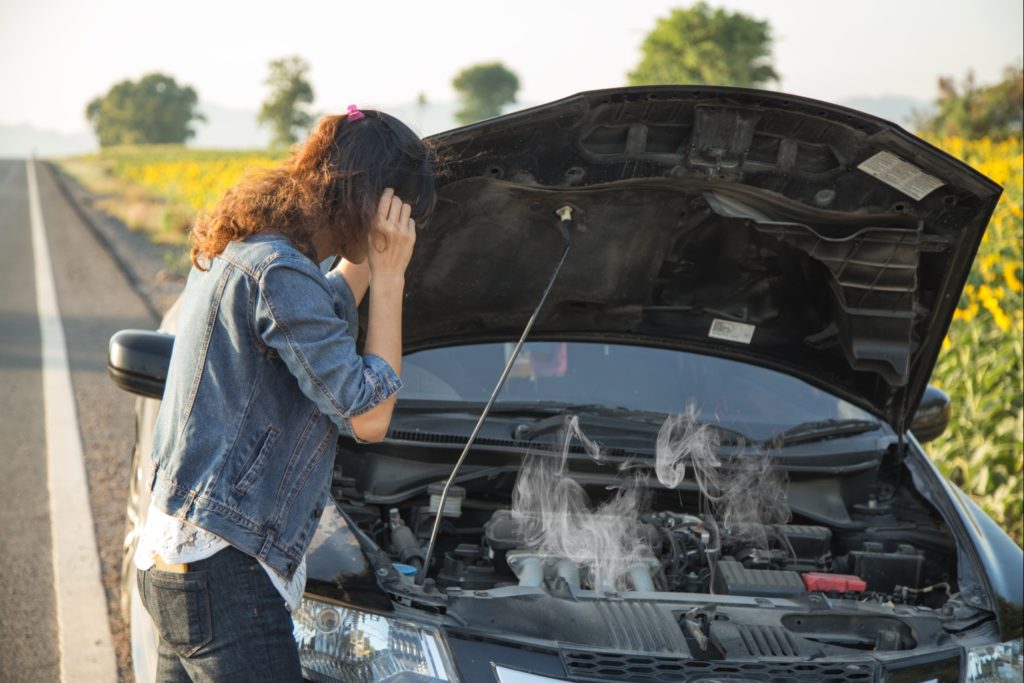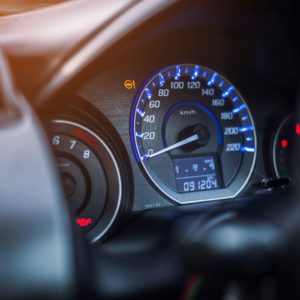All traditional automatic transmissions rely on a torque converter located between the engine and the transmission. Because the torque converter is out of sight and out of mind, it’s often forgotten until problems start to arise.
If your car’s torque converter is going out, you’ll likely notice one or more troubling symptoms. You’ll want to address the issue as soon as possible to avoid potentially damaging the transmission.
What Does a Torque Converter Do?

Traditional automatics and most continuously variable transmissions rely on a fluid coupling device called a torque converter. The torque converter keeps the vehicle from stalling when coming to a stop. In addition, the torque converter multiplies engine torque under acceleration to increase pulling power.
You’ll find the torque converter located between the engine and the transmission. One side of the converter fits over the transmission’s input shaft and the other side bolts to a flexplate at the back of the engine.
Five primary components—the impeller, stator, turbine, clutch, and front cover—make up the converter assembly. When the vehicle is running, the impeller is driven by the engine and acts as a centrifugal pump. The impeller forces fluid outward toward the turbine, which is connected to the transmission’s input shaft, causing the turbine to spin.

The stator, which is supported by a one-way clutch, is positioned between the impeller and the turbine. When the stator is “locked” (and engine speed is above idle), it directs fluid flow between the impeller and turbine in such a way that a significant amount of centrifugal force is available to act on the turbine. As a result, engine torque is multiplied. The difference between impeller speed and turbine speed also forces the vehicle to start moving.
Once impeller speed and turbine speed are about the same, the direction of the fluid flow changes, and the converter begins to enter its “coupling” phase. The change in fluid flow causes the one-way clutch to release, allowing the stator to spin freely. At this point, engine torque is no longer multiplied.

Also, the torque converter allows the vehicle to come to a stop without stalling. This is possible because, when engine speed is low, the impeller turns slowly and produces minimal centrifugal force.
All modern torque converters have a lockup clutch positioned between the turbine and front cover. The clutch eliminates the energy-wasting slippage within the torque converter by creating a mechanical connection between the engine and the transmission. When conditions are correct, the clutch, which is splined to the turbine, presses against the converter cover to create the connection.
Hydraulic fluid is used to apply the torque converter clutch. A computer—often referred to as the transmission control module (TCM)—looks at data from various sensors to determine when to apply the clutch. Once the TCM has deemed conditions are correct, it operates a solenoid valve to allow fluid flow to activate the converter clutch.
The video below covers torque converter operation:
Common Signs Of a Bad Torque Converter
If your car’s torque converter starts to fail, you’ll likely notice one or more of the following symptoms:
Illuminated Check Engine Light
On modern vehicles, the TCM monitors torque converter operation. If the module detects a problem with the converter or its control circuitry, the device will turn on the check engine light and store a diagnostic trouble code (DTC) in its memory. Some vehicles may also turn on a separate transmission warning light when there’s a problem.
Shuddering
Torque converter shudder is a common problem that results in a vibration before or after torque converter clutch lockup. On older vehicles, the vibration was usually felt around 40 to 50 MPH, when lockup took place. But many late-model vehicles gradually apply the torque converter clutch, so the shuddering may happen at different speeds.
Stalling
If the torque converter clutch fails to release, the vehicle may stall when coming to a stop. The problem will feel much like a manual transmission vehicle stopping with the clutch engaged (pedal released).
Overheating
A converter clutch that stays locked up can cause an increase in engine coolant temperature. Similarly, a locked stator one-way clutch can cause the engine to overheat under cruise conditions. A locked one-way clutch can also cause the transmission fluid to get extremely hot, potentially leading to internal transmission damage.

Abnormal Noise
Worn needle bearings inside of the torque converter can create a whirring noise that coincides with engine speed. The noise is typically present when the transmission is in gear. In neutral, the sound tends to go away.
Additional Performance Problems
A faulty torque converter can lead to a variety of issues that might seem like engine performance problems. For example, if the stator’s one-way clutch is freewheeling, the vehicle may suffer from poor acceleration from a stop. On the other hand, if the one-way clutch is locked, the vehicle may exhibit a lack of power at highway speeds.
The converter clutch can also cause problems. If the clutch fails to engage, it can increase engine RPMs and reduce fuel economy.
How To Tell If a Torque Converter Is Bad
In some cases, you can check the health of the torque converter by performing a stall speed test. The test involves putting the vehicle in gear with the brake pedal depressed, pressing the accelerator pedal to the floor, and noting the maximum engine speed (stall speed) on the dashboard.
A stall speed that’s higher than specification indicates an internal transmission problem. Meanwhile, a stall speed that’s lower than specification points to either a defective torque converter or an engine performance problem.
Unfortunately, torque converter stall testing is not recommended for all vehicles. Consult a repair manual or repair database to see if stall speed testing is possible for your application.
Professionals typically test the torque converter clutch by driving the vehicle with an OEM-level scan tool connected to the onboard diagnostic port. The torque converter clutch data on the tool will usually indicate when and/or how much the clutch is applied. On some vehicles, the scan tool can also be used to directly activate the converter clutch. Converter clutch engagement should happen smoothly with minimal slippage.

Torque Converter FAQ
Absolutely. A faulty torque converter can cause the transmission to overheat, resulting in extensive internal damage. What’s more, debris from a faulty converter can cause problems by circulating throughout the transmission.
While there are companies that specialize in overhauling torque converters, the practice is rather uncommon. Very few repair shops will attempt to rebuild a torque converter—replacement is usually the only option.
No. The transmission must be removed to access and replace the torque converter.
Sometimes, but not always. Most torque converter-related codes have to do with the torque converter clutch. Other issues with the converter are less likely to set a code.
Other Notes About Torque Converter
Here are some generic codes related to the torque converter:
- P0740 Torque Converter Clutch Circuit/Open
- P0741 Torque Converter Clutch Circuit Performance/Stuck Off
- P0742 Torque Converter Clutch Circuit Stuck On
- P0743 Torque Converter Clutch Circuit Electrical
- P0744 Torque Converter Clutch Circuit Intermittent
- P2756 Torque Converter Clutch Pressure Control Solenoid
- P2757 Torque Converter Clutch Pressure Control Solenoid Control Circuit Performance/Stuck Off
- P2758 Torque Converter Clutch Pressure Control Solenoid Control Circuit Stuck On
- P2759 Torque Converter Clutch Pressure Control Solenoid Control Circuit Electrical
- P2760 Torque Converter Clutch Pressure Control Solenoid Control Circuit Intermittent
- P2761 Torque Converter Clutch Pressure Control Solenoid Control Circuit/Open
- P2762 Torque Converter Clutch Pressure Control Solenoid Control Circuit Range/Performance
- P2763 Torque Converter Clutch Pressure Control Solenoid Control Circuit High
- P2764 Torque Converter Clutch Pressure Control Solenoid Control Circuit Low
- P2769 Torque Converter Clutch Circuit Low
- P2770 Torque Converter Clutch Circuit High
- P2783 Torque Converter Temperature Too High
Getting a Replacement Torque Converter that Fits Your Car
You might not immediately notice or recognize the torque converter, but older automatic transmissions rely on it. If the converter fails and locks up with the clutch, your vehicle might shudder, stall while braking, or overheat. Fortunately, a quality torque converter is only a few clicks away here at CarParts.com.
Here at CarParts.com, we eliminate the need to play a guessing game with the compatibility of auto parts. We give accurate and detailed information on our product fitment, and our website’s integrated vehicle selector makes it easy to find the right part. Ordering only takes several clicks, and our ready-to-ship products can reach your home in as quick as two business days.
Browse our selection of torque converters here at CarParts.com and shop now.
Any information provided on this Website is for informational purposes only and is not intended to replace consultation with a professional mechanic. The accuracy and timeliness of the information may change from the time of publication.





























